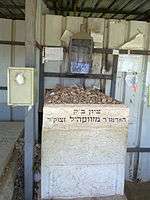Sheikh Badr Cemetery
Sheikh Badr Cemetery (also Givat Ram cemetery)[2] is an 8 dunams (0.80 ha; 2.0 acres)[1] Jewish burial ground in west-central Jerusalem, Israel. It was established as a temporary burial ground during the 1948 Arab siege of Jerusalem. Most of its military and civilian graves were transferred to Mount Herzl and Har HaMenuchot, respectively, in late 1950. The cemetery continued to accept burials up until the official opening of Har HaMenuchot in November 1951.
| Details | |
|---|---|
| Established | May 31, 1948 |
| Location | |
| Country | Israel |
| Size | 8 dunams (0.80 ha; 2.0 acres)[1] |
Location
The cemetery lies between the Israeli Supreme Court building to the south and Sacher Park to the north, on land belonging to the former Arab village of Sheikh Badr. This village was depopulated in January 1948, during the 1947–1948 Civil War in Mandatory Palestine, on the order of the Haganah.[3]
History
Until 1948, Jewish burials in Jerusalem were conducted in the centuries-old Jewish cemetery on the Mount of Olives. In January 1948, the Arab siege of Jerusalem made the Mount of Olives inaccessible, as the route to the cemetery passed through hostile Arab villages.[4] A new burial ground was opened next to the Sanhedria neighborhood on the northern border on March 28, 1948.[5] However, with the outbreak of war in May 1948, the Sanhedria Cemetery lay on the front line and funerals were plagued by sniper fire.[5] Two temporary burial grounds in central Jerusalem – Sheikh Badr Cemetery, and Shaare Zedek Cemetery behind the first Shaare Zedek Hospital – were then opened.[6]
The Sheikh Badr cemetery opened on May 31, 1948 with 76 burials. It was designated as a temporary burial ground with the understanding that the bodies would be reburied in another, permanent cemetery after the war. To that end, the city rabbis ruled that, unlike regular Jewish burials in Israel in which the deceased is placed directly into the grave, the deceased in Sheikh Badr should be placed in wooden caskets to expedite their removal once the war ended.[7]
As the military and civilian death toll from the war increased, there was much confusion over the burials, as cemetery workers and carpenters had all been drafted.[7] An adjoining quarry was also used for burials; here, bodies were buried in three layers,[6] one atop the other, with a layer of dirt between each one.[7]
After the war ended, it became clear that the Mount of Olives would be inaccessible for an indefinite period of time. The Sheikh Badr cemetery continued to function. Bodies were still placed in wooden caskets, but the caskets were not buried in the earth – they were placed in open spaces on the ground and covered on all sides with dirt.[7]
In late 1950, bodies began to be transferred out of the Sheikh Badr cemetery. The graves of 300 soldiers were transferred to Mount Herzl and the graves of 600 civilians were transferred to Har HaMenuchot. Burials continued at the Sheikh Badr cemetery until the official opening of Har HaMenuchot in November 1951. In mid-1955, the decision was made to bury the remaining bodies in the Sheikh Badr cemetery in earth and to erect a headstone over each grave.[7]
Though the cemetery is no longer in use, it saw its first burial in over 50 years in October 2002, when the family of a Bnei Brak resident buried him next to his father in Sheikh Badr.[6]
Grave of the Zvhiller Rebbe

Since 2008, the grave of Rabbi Gedalia Moshe Goldman, the Zvhiller Rebbe,(1887–1950)[8] has become a popular site for visitors. A segulah has developed around the grave, in which petitioners who visit it on a consecutive Monday, Thursday, and Monday and pray for what they desire will have their wish fulfilled.[9][10]
References
- Avni, Eran (13 January 2008). בתי קברות יהודיים בירושלים [Jewish Cemeteries in Jerusalem] (in Hebrew). Machon Yerushalayim Lechaker Yisrael. Retrieved 31 October 2012.
- In the Land of Israel: My Family 1809-1949
- Morris, Benny (2003). The Birth of the Palestinian Refugee Problem Revisited. Cambridge University Press. p. 121. ISBN 0521009677.
- Bar-Am, Aviva (31 December 2010). "The Path of Justice". The Jerusalem Post. Archived from the original on 10 June 2014. Retrieved 7 October 2012. (subscription required)
- Rossoff, Dovid (2005). קדושים אשר בארץ: קברי צדיקים בירושלים ובני ברק [The Holy Ones in the Earth: Graves of Tzaddikim in Jerusalem and Bnei Brak] (in Hebrew). Jerusalem: Machon Otzar HaTorah. pp. 335–336.
- Samsonowitz, M. (16 October 2002). "Burial in Jerusalem: The Har Menuchos Cemetery – Part I". Dei'ah VeDibur. Retrieved 7 October 2012.
- Rossoff (2005), pp. 389–390.
- Rossoff (2005), p. 391.
- Davidson, Nadav; Rosenberg, Oz (1 February 2011). תופעה חדשה בי-ם: עשרות מאמינים פוקדים את קבר הצדיק בגן סאקר [New Happening in Jerusalem: Dozens of believers visit the grave of the tzaddik in Sacher Park]. Maariv (in Hebrew). Retrieved 28 October 2012.
- מחנה פליטים בעזה או קבר של אדמו"ר? [A Refugee Camp in Gaza or A Rebbe's Grave?]. News1 (in Hebrew). 1 September 2011. Retrieved 28 October 2012.
| Wikimedia Commons has media related to Sheikh Badr cemetery. |